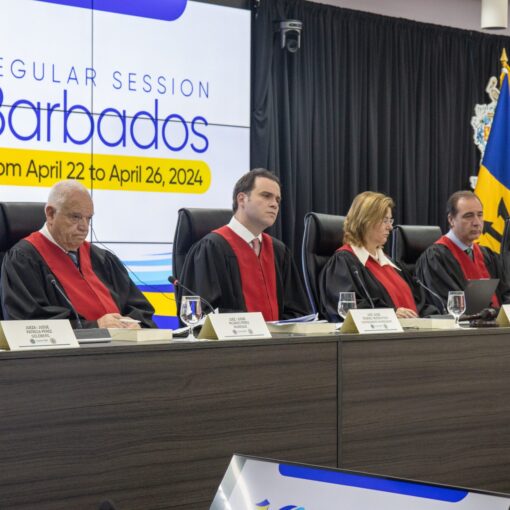Each month, Arnold & Porter and the Center for Climate Change Law collect and summarize developments in climate-related litigation, which we also add to our U.S. and non-US climate litigation charts. The January additions are listed below. (If you know of any cases we’ve missed, please email us at columbiaclimate at gmail dot com.)
FEATURED DECISION
WildEarth Guardians v. Jewell (D.C. Cir. Dec. 24, 2013): added to the “Stop Government Action/NEPA” slide. Environmental groups achieved a standing victory but ultimately lost the battle when they appealed a district court ruling that they did not have standing to pursue their claims that a final environmental impact statement (FEIS) prepared by the Bureau of Land Management (BLM) inadequately addressed climate change. BLM had prepared the FEIS prior to its approval of tracts of federal land in Wyoming for leasing for coal mining. The groups also appealed the district court’s determination that BLM’s consideration of other types of environmental impacts had been adequate. The D.C. Circuit reversed the holding on standing, finding that the district court “sliced the salami too thin” when it required that the specific type of pollution causing the environmental groups’ injury be the same type that was considered inadequately in the FEIS. The D.C. Circuit concluded that the harm to the groups’ members’ recreational and aesthetic interests caused by local pollution was a sufficient injury in fact to challenge all of the alleged deficiencies in the FEIS, including those related to global climate change. On the merits, however, the D.C. Circuit called the alleged climate change-related inadequacies “of the flyspecking variety” and concluded that BLM had satisfied its obligations to consider climate change under the National Environmental Policy Act.
DECISIONS AND SETTLEMENTS
Sierra Club v. BNSF Railway Co. (E.D. Wash. Jan. 2, 2014): added to the “Challenges to Coal-Fired Power Plants” slide. Seven environmental groups commenced a lawsuit in the federal district court for the Eastern District of Washington against BNSF Railway Co. (BNSF) alleging that BNSF’s operation of rail lines to carry coal violated the Clean Water Act (CWA). In the facts section of their complaint, the environmental groups alleged that BNSF’s trains and rail cars discharged coal and coal dust “to waters of the United States when traveling adjacent to, over, and in proximity to waters of the United States” and that the trains and rail cars were point sources. The district court denied BNSF’s motion to dismiss, which was grounded in BNSF’s contention that coal from rail cars that falls on land and not directly into waters does not violate the CWA. The court found that since plaintiffs’ claim alleged that coal pollutants were discharged “into” waterways, it was necessary to permit plaintiffs to develop facts to support their claim.
Fix the City v. City of Los Angeles; La Mirada Avenue Neighborhood Association of Hollywood v. City of Los Angeles; Save Hollywood.org v. City of Los Angeles (Cal. Super. Ct. Dec. 10, 2013): added to the “State NEPAs” slide. A California Superior Court issued a tentative decision in three related cases challenging the Hollywood Community Plan Update (HCPU), which would, among other things, increase density near public transit stops. If issued as a final decision, the court’s ruling would invalidate the HCPU. The court found that the environmental impact report prepared under the California Environmental Quality Act was flawed, including its outdated assumptions regarding population and its inadequate consideration of alternatives. The City issued a letter on December 20 acknowledging the uncertainty created by the tentative decision and indicating that it remained committed to the principles of the HCPU.
Thrun v. Cuomo (N.Y. App. Div. Dec. 5, 2013): added to the “Industry Lawsuits/Challenges to State Action” slide. The New York Appellate Division affirmed the dismissal of a challenge to New York’s participation in the Regional Greenhouse Gas Initiative (RGGI), a nine-state cap-and-trade program restricting carbon dioxide emissions from the power sector. The court below had dismissed the challenge on standing and laches grounds. The appellate court assumed without deciding that plaintiffs had standing, but ruled that the causes of action challenging the validity of RGGI regulations issued by the New York State Department of Environmental Conservation and the New York State Energy Research and Development Authority were time barred because, as challenges to “quasi-legislative” acts, they could have been brought in an Article 78 proceeding despite their constitutional underpinnings, and were thus governed by the four-month statute of limitations for Article 78 proceedings. The claims therefore were made two and a half years too late. The appellate court further ruled that the challenges to then-Governor George Pataki’s signing of the RGGI memorandum of understanding (MOU) were moot because the MOU did not effectuate the RGGI program or New York’s participation in it, and undoing the MOU would not redress the claimed injuries.
Alliance for the Wild Rockies v. Brazell (D. Idaho, Nov. 27, 2013): added to the “Stop Government Action/NEPA” slide. The federal district court for the District of Idaho granted federal defendants’ motion to dismiss a challenge to the Little Slate Project, a set of actions including aquatic habitat restoration, timber harvest, fuel treatments, and changes to the roads and trails intended to improve conditions in the Little Slate Creek watershed in Idaho. Plaintiffs challenged federal decisions under the National Environmental Policy Act, the Endangered Species Act, and the National Forest Management Act. The court found that the defendants had not acted arbitrarily or capriciously. Although climate change impacts were not central to the federal defendants’ or the court’s analysis, the court noted that a biological opinion for bull trout prepared by the Fish and Wildlife Service identified global climate change as a cumulative effect and “determined the ‘quite certain’ warming of the global climate would have negative effects on bull trout habitat.”
POET, LLC v. California Air Resources Board (Cal. Nov. 20, 2013): added to the “Industry Lawsuits/Challenges to State Action” slide. The California Supreme Court denied the California Air Resource Board’s (CARB’s) petition for review of the appellate court decision requiring CARB to set aside its approval of California’s low carbon fuel standard (LCFS) and to take steps to rectify errors in its approval process, including the improper deferral of the formulation of mitigation measures for potential increases in nitrogen oxide emissions from biodiesel without committing to specific performance criteria for judging the efficacy of the future mitigation measures. The LCFS will remain in effect while CARB undertakes the required actions. The California Supreme Court also denied CARB’s depublication request for the appellate court’s decision.
NEW CASES, MOTIONS, AND NOTICES
Energy Conservation Program for Consumer Products, Notice of Denial of Petition for Reconsideration by Landmark Legal Foundation (78 Fed. Reg. 79,643, Dec. 31, 2013): added to the “Challenges to Federal Action” slide. On December 31, 2013, the Office of Energy Efficiency and Renewable Energy of the U.S. Department of Energy (DOE) denied an August 2013 petition from the Landmark Legal Foundation (LLF) for reconsideration of the final rule for Energy Conservation Standards for Standby Mode and Off Mode for Microwave Ovens. LLF had requested reconsideration because the final rule used a different “social cost of carbon” (SCC) than the supplementary notice of proposed rulemaking. In denying the petition, DOE indicated that the SCC values used in the proposed rule and in the final rule had not affected DOE’s decision because the estimated benefits of the proposed and final standard exceeded the standard’s costs even without considering SCC values. In fact, the proposed and final standard were the same. DOE also said that the use of an updated SCC value in the final rule did not violate the Administrative Procedure Act’s notice and comment requirements because, among other reasons, DOE had indicated in its notice of proposed rulemaking that the SCC values were subject to change based on improved scientific and economic understanding of climate change and because the change in the SCC values reflected refinements to underlying models, not to methodology or federal government inputs such as discount rates, population growth, climate sensitivity distribution, or socio-economic trajectories.
In re La Paloma Energy Center, LLC (EAB, filed Dec. 6, 2013): added to the “Stop Government Action/Project Challenges” slide. On December 6, 2013, the Sierra Club petitioned the Environmental Appeals Board for review of a Prevention of Significant Deterioration (PSD) permit issued by EPA Region VI for a natural gas-fired combined cycle electric generating plant in Harlingen, Texas. Sierra Club contended that Region VI erred by setting three different greenhouse gas best available control technology (BACT) limits and allowing the applicant to determine which limit would apply based on which of three turbine designs the applicant ultimately selected for the power plant. Sierra Club also argued that Region VI “clearly erred by refusing to consider solar thermal hybrid addition to the proposed natural gas combined cycle power plant, despite being a demonstrated method to reduce greenhouse gas emissions without changing the fundamental business purpose of producing electricity through a combined cycle power plant.”
Sierra Club v. U.S. Environmental Protection Agency (9th Cir., filed Sept. 6, 2013): added to the “Stop Government Action/Project Challenges” slide. Sierra Club and three other environmental organizations petitioned the Ninth Circuit for review of EPA’s decision to extend the deadline for commencing construction of the 600-MW natural gas-fired Avenal Energy Project in the San Joaquin Valley in California pursuant to a PSD permit issued in 2011. A challenge to the 2011 permit—which did not require implementation of greenhouse gas (GHG) controls because the permit application was submitted before GHG requirements became effective and because EPA failed to act in a timely manner on the application—is also pending in the Ninth Circuit. The Ninth Circuit held oral argument in that action on October 8, 2013. In announcing the challenge to the construction deadline extension, the Center for Biological Diversity, one of the environmental organizations bringing the lawsuit, said that the exemption from the deadline was “contrary to decades of EPA precedent” and was based on Avenal’s “specious claim that it could not obtain financing for the project due to the existing litigation.”
Here are recent additions to the Non-U.S. Climate Litigation Chart.
In the Matter of subsection 17(40) of the Planning Act, R.S.O 1990, P.13 as amended The City of Brampton filed a motion seeking partial approval of the amendment its 2006 Official Plan. The plan was amended to include climate change considerations with respect to transportation, sustainable development, climate change adaptation and mitigation, and energy efficiency and management. The partial approval was granted. —Added to “Environmental Assessment and Permitting: Other Projects” slide.




